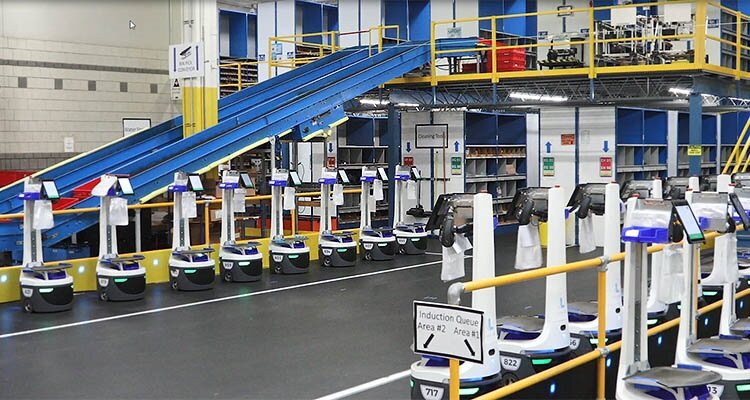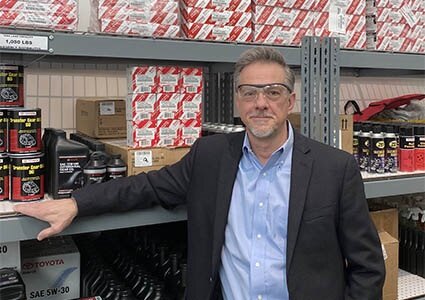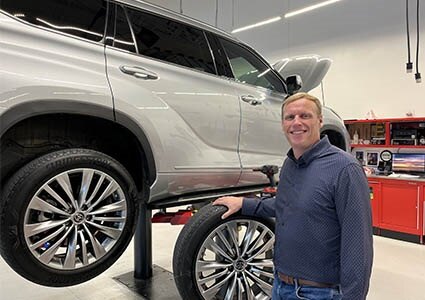
Why Toyota Motor Corporation is remaining optimistic in a potentially declining market
Toyota Motor Corporation (Toyota) needs no introduction. Founded in Tokyo in 1937, the Japanese multinational has grown to become one of the largest automotive manufacturers in the world, capable of producing around ten million vehicles per year.
Such growth comes hand-in-hand with the demand for high-quality service parts, which means relying on a strong, well-managed supply chain. We’re lucky enough to sit down with Mike Schober, Vice President of Toyota Service Parts Operations for North America, and Michael Schad, General Manager, to discuss the power of supply chain in the automotive industry’s evolving landscape.

“There’s been more change over the last few years than I’ve ever seen in my 37-year career,” begins Mike. “We faced a lot of challenges moving through the pandemic, as well as pre-existing issues that were accelerated by this period, particularly the global shortage of accessible labor and ever-changing consumer expectations.”
These challenges have been exacerbated by a sustained surge in automobile and service parts demand that has not abated since the end of the pandemic. Mike proposes: “It’s not just a Toyota or automotive phenomenon, but I think across many consumer product industries, there was, and in some cases still is, significant pressure to move a lot of products not only through the domestic supply chain, but also the global supply chain. This places considerable pressure on certain nodes of our supply chain, creating huge ripple effects.
“We’re then dealing with the additional challenges of systemic issues,” Mike continues. “Firstly, the short supply of labor was already becoming a problem, but the pandemic really pushed it to the forefront. There’s a growing age gap in the general workforce, with many of our longstanding team members reaching retirement and a lack of young people coming through the ranks. Combined with surging demand and rising inflation, many organizations are experiencing continued instability across supply and transportation bases.”
Michael adds: “The other difficulty lies with the evolution of consumer demand and expectations over the last ten years, which has been fueled by internet technology and the likes of next-day delivery, but again, the pandemic heightened the demand for convenience. Staying ahead of ever-evolving customer expectations for speed and convenience in a fast-changing market is one of our biggest focus areas today.
“We’ve always put customers at the center of everything we do, but Mike set a vision coming out of the pandemic to pay close attention to changing demands and expectations,” Michael continues. “We lean on our close relationships with suppliers to navigate severe availability and delivery issues, particularly in developing strategies that help us execute on time, any place delivery. We leverage these relationships to better understand how we, as a supply chain organization, can better satisfy our customers.”
Mike agrees: “Toyota is a very supplier-focused company that encourages strong working relationships and was founded upon the principle of respect for humanity. When it comes to navigating some of the issues we’ve outlined, as well as improving production capacity and throughput, collaboration is absolutely key.
“This approach extends to our team members too, as our goal of respect means recognizing that everyone has individual value and that things are best accomplished as a team. For example, we quickly recognized that we couldn’t service post-pandemic demand with our existing warehouse shift schedules, which forced us to be creative and question our traditional paradigms. At our highest volume fulfilment center, for example, we worked with our team members to develop a schedule that not only suits their lifestyles but also allows the facility to open seven days a week.”
Technology transformation
One of the key ways Toyota is navigating change is through embracing technology and automation. “We look at technology through a cautious and respectful lens, finding ways that technology can help, as opposed to replace, our team members,” Mike says. “The difference between automation and humans is that while automation can learn, people provide creativity, ingenuity, and can exploit Kaizen to grow their capabilities.
“Technology can, of course, add value and efficiency when used in collaboration with our team, especially in areas that include difficult, manual work or require precision. There are two key technologies we’ve implemented that we’re already feeling the benefits of in terms of efficiency, capacity, and ergonomic considerations.
“Firstly, we’ve incorporated person-to-goods technology in our smaller warehouses using Locus Robotics (Locus). Team members can give the bot an assignment and it will then go to each part location to pick the parts, meaning the employee can simply go to the bot’s final location, as opposed to finding each item while pushing heavy carts. It has tremendous ergonomic benefits and is particularly useful during periods of high seasonal demand.”

Offering notable examples of how people can leverage the benefits of technology, Mike continues: “Using Swisslog robotics, we’ve also implemented goods-to-person automated technology in our largest fulfilment center, which pick up and bring entire racks to the required area for receiving, picking, and packing. Like Locus, it brings ergonomic benefits while simultaneously helping us achieve double-digit improvements to productivity and efficiency.”
Michael interjects: “It’s also important for us to look at the technology being used at our dealerships and ensure we position our supply chain and fulfillment to meet new requirements. Toyota Service Connect, for example, delivers information via a mobile app to our customers concerning their vehicle’s maintenance needs using data transmission from their car. Using this data, we’re planning to schedule service appointments directly from customers’ phones, which requires us to look for new ways to provide more personalized fulfilment like the on-demand parts delivery we’re currently trialing.”
Navigating change
Having highlighted some of the ways in which the company is tackling industry-wide issues, the conversation turns to Mike’s predictions of the market ahead. “Many of the post-pandemic issues we’ve talked about are transient. We’ll work through them alongside our suppliers and dealers through continued process improvements, but the real challenge comes once we’ve worked through those issues – where do we go from there?
“There’s so much change happening in the automotive industry right now with the rise of technology and the movement towards electrification. My focus is always looking ahead, preparing for what’s coming next, and we’re taking a very optimistic view of the future. Some automotive supply chain businesses see the rise of electric vehicles (EVs) as a threat, with many parts like oil filters and engine components decreasing in demand as electric increasingly replaces internal combustion engines.
“While some predict a potential double-digit reduction in service parts order volume, we see the future as an opportunity for strategic growth,” Mike suggests. “Despite the changing market, our mission is to develop strategies and new revenue opportunities that allow us to recapture any lost profit and support the overall company through this transition to a new future.
“To plan for this, we’re looking at our supply chain in an entirely different way than we ever have before. It’s easy to consider a fulfillment business as a back-office operation, but it’s an outdated view that needs transforming; we’re no longer a support function, but a source of competitive and strategic advantage. We don’t just fulfil demand for parts, we also help to grow retention and revenue, especially against the aftermarket through a more agile and customer responsive supply chain.
“We’ll continue to focus on building customer retention by bringing the supply chain closer, shortening lead times, and offering more services than the aftermarket,” Mike explains. “We’ve established a customer promise of industry-best fulfilment time to reflect our commitment to service, for example, and we’re currently part of some collaborative pilot schemes to further strengthen the speed and agility of our order to delivery cycle. When it comes to our facilities, we ensure that they are strategically located to serve the surrounding market, with additional sites recently opening in Phoenix, Atlanta, and Orlando.
“As shared earlier, the rise of technology and connectivity poses an interesting opportunity. Customers are demanding greater mobility around everything, from booking a service appointment to receiving software system updates. As technology continues to advance, our challenge is to figure out how we can pivot within the service parts business to meet demand in the more agile environment that our vehicles and customers are moving towards.”
From our conversation, it’s clear to see that Mike is always one step ahead, contemplating how trends and changes in the market will impact the business moving forward. “We’re constantly evaluating our strategy to grow the service parts division in a potentially declining future market,” Mike concludes. “I’d like to see some of our pilot schemes come to fruition to reduce customer friction, but the main goal for me personally is to remain an exciting, vibrant, and fast-moving source of competitive advantage for the overall company.”